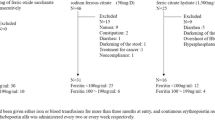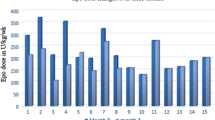Abstract
About 12–15 % of hemodialysis patients have a poor response to recombinant human erythropoietin (rHuEPO). The aim of this prospective study was to examine the influence of oxidative stress and vitamin E supplementation on rHuEPO responsiveness in chronic hemodialysis patients. Sixty-five hemodialysis patients treated with rHuEPO were studied. Those with iron deficiency, blood loss, malignancy, vitamin B12 and folate deficiency, severe hyperparathyroidism, liver cirrhosis, and congestive heart failure were excluded. Twenty-one healthy volunteers served as a control group. Malondialdehyde, carbonyl proteins, erythrocyte superoxide dismutase (SOD), ceruloplasmin, and serum antioxidant capacity were measured. Values of SOD > 150 U/ml were considered as normal. Patients with SOD < 150 U/ml were divided in two groups: group A (n = 11): treated with vitamin E 400 mg/day (600 IU/day) for 8 weeks; group B (n = 13): not treated. A third, group C consisted of patients with normal SOD. rHuEPO doses (U/kg/week) were recorded. rHuEPO responsiveness index was calculated as rHuEPO U/week/hematocrit. A poor response was defined as a rHuEPO responsiveness index >200. SOD positively correlated with hemoglobin (p = 0.0018, R = 0.337) and negatively with rHuEPO responsiveness index (p = 0.0122, R = 0.319). Vitamin E-treated patients from group A exhibited significantly increased hemoglobin levels as compared to initial values (10.5 ± 0.3 vs. 8.6±0.4, p = 0.002). In comparison with group B, the vitamin E-treated patients displayed a higher hemoglobin (10.5 ± 0.3 vs. 9.4 ± 0.3, p = 0.04), had a lower rHuEPO dose (85.7 ± 7.4 vs. 136.8 ± 13.8, p = 0.025), and a significantly improved rHuEPO responsiveness (rHuEPO responsiveness index 177.9 ± 28.6 vs. 314.1 ± 34.0, p = 0.006). Patients from group A significantly improved their rHuEPO responsiveness after vitamin E therapy as compared to baseline (rHuEPO responsiveness index 177.9 ± 28.6 vs. 271.7 ± 30.3, p = 0.034). We conclude that lower values of SOD correlate with lower hemoglobin, higher rHuEPO dose and poor response to rHuEPO in chronic hemodialysis patients. Vitamin E supplementation significantly improves rHuEPO responsiveness, increases hemoglobin level, and decreases rHuEPO dose.







Similar content being viewed by others
References
Macdougal IC, Cooper AC (2002) Erythropoietin resistance: the role of inflammation and pro-inflammatory cytokines. Nephrol Dial Transplant 17(Suppl 11):39–43
NKF-K/DOQI Clinical Practice Guidelines for Anemia of Chronic Kidney Disease (2001). Am J Kidney Dis 37 (suppl 1):S182–238
Nitta K, Akiba T, Takei T et al (2002) Inflammation and resistance to erythropoietin in hemodialysis patients. Acta Haematol 108:168–170
Ceballos-Picot I, Witko-Sarsat V, Merad-Boudia M et al (1996) Glutathione antioxidant system as a marker of oxidative stress in chronic renal failure. Free Radical Biol Med 21:845–853
Locatelli F, Canaud B, Eckardt K-U et al (2003) Oxidative stress in end-stage renal disease: an emerging threat to patient outcome. Nephrol Dial Transplant 18:1272–1280
Handelman GJ (2000) Evaluation of oxidant stress in dialysis patients. Blood Purif 18:343–349
Jackson P, Loughrey CM, Lightbody JH et al (1995) Effect of hemodialysis on total antioxidant capacity and serum antioxidants in patients with chronic renal failure. Clin Chem 41:1135–1138
Stenvinkel P, Barany P (2002) Anemia, rHuEPO resistance and cardiovascular disease in end-stage renal failure: links to inflammation and oxidative stress. Nephrol Dial Transplant 17(suppl 5):32–37
Sies H (1997) Oxidants and antioxidants. Exp Physiol 82:291–295
Cruz DN, de Cal M, Ronco C (2008) Oxidative stress and anemia in chronic hemodialysis: the promise of bioreactive membranes. Contrib Nephrol 161:89–98
Cristol JP, Bosc JY, Badiou S et al (1997) Erythropoietin and oxidative stress in hemodialysis: beneficial effects of vitamin E supplementation. Nephrol Dial Transplant 12:2312–2317
Loughrey CM, Yung IS, Lightbody GH et al (1994) Oxidative stress in hemodialysis. Q J Med 86:679–683
Paul JL, Sall ND, Soni T et al (1993) Lipid peroxidation abnormalities in hemodialysis patients. Nephron 64:106–109
Cavdar C, Camsari T, Semin I et al (1997) Lipid peroxidation and antioxidant activity in chronic hemodialysis patients treated with recombinant human erythropoietin. Scand J Urol Nephrol 31:371–375
Ludat K, Sommerburg O, Grune T et al (2000) Oxidation parameters in complete correction of renal anemia. Clin Nephrol 53:S23–S29
Sommerburg O, Grune T, Hampl H et al (2000) Does treatment of renal anemia with recombinant erythropoietin influence oxidative stress in hemodialysis patients? Clin Nephrol 53:S23–S29
Canaud B, Cristol JP, Morena M et al (1999) Imbalance of oxidants and antioxidants in hemodialysis patients. Blood Purif 17:99–106
Nguyen-Khoa T (2001) Oxidative stress in hemodialysis. Nephrol Dial Transplant 16:335–340
Halliwell B (1994) Free radicals and antioxidants. Nutr Rev 52:253–265
Pastor MC (1993) Serum and erythrocyte tocopherol in uremic patients. Am J Nephrol 13:238–243
Descamps-Latscha B, Goldfarb B, Nguyen AT et al (1991) Establishing the relationship between complement activation and stimulation of phagocyte oxidative metabolism in hemodialysis patients. Nephron 59:279–285
Takahashi K, Cohen HG (1986) Glutathione peroxidase protein, selenium deficiency and correlation with enzymatic activity. J Clin Invest 77(4):1402–1404
Tepel M, Echelmeyer M, Orie NN et al (2000) Increased intracellular reactive oxygen species in patients with end-stage renal failure; effect of hemodialysis. Kidney Int 58:867–872
Hasselwander O, Young IS (1998) Oxidative stress in chronic renal failure. Free Radic Res 29:1–11
Tetta C, Biasioli S, Schiavon R et al (1999) An overview of hemodialysis and oxidative stress. Blood Purif 17:118–126
Canestrari F, Galli F, Giorgini A et al (1994) Erythrocyte redox state in uremic anemia: Effects of hemodialysis and relevance of glutathione metabolism. Acta Haematol 91:187–193
Westhyzen J, Saltisi D, Stanbury V (2003) Oxidative stress and erythrocyte integrity in end-stage renal failure patients hemodialysed using vitamin E-modified membrane. Ann Clin Lab Sci 33:3–10
Triolo L, Malaguti M, Ansali F et al (2003) Vitamin-E bonded cellulose membrane, lipoperoxidation and anemia in hemodialysis patients. Artif Cells Blood Substit Immobil Biotechnol 31(2):185–191
Usberti M, Gerardi G, Micheli A et al (2002) Effect of vitamin E-bonded membrane and glutathione on anemia and erythropoietin requirements in hemodialysis patients. J Nephrol 15(5):558–564
Yang C-C, Hsu S-P, Wu M-S et al (2006) Effects of vitamin C infusion and vitamin E—coated membrane on hemodialysis and oxidative stress. Kidney Int 69:706–714
Giardini O, Taccone-Gallucci M, Lubrano R et al (1984) Effects of alpha-tocopherol administration on red blood cell membrane lipid peroxidation in hemodialysis patients. Clin Nephrol 21:174–177
Nemeth I, Turi S, Haszon I et al (2000) Vitamin E alleviates the oxidative stress of erythropoietin in uremic children on hemodialysis. Pediatr Nephrol 14(1):13–17
Massy ZA, Nguyen-Khoa T (2002) Oxidative stress and chronic renal failure: markers and management. J Nephrol 15(4):336–341
Author information
Authors and Affiliations
Corresponding author
Rights and permissions
About this article
Cite this article
Rusu, A., Rusu, F., Zalutchi, D. et al. The influence of vitamin E supplementation on erythropoietin responsiveness in chronic hemodialysis patients with low levels of erythrocyte superoxide dismutase. Int Urol Nephrol 45, 495–501 (2013). https://doi.org/10.1007/s11255-012-0175-3
Received:
Accepted:
Published:
Issue Date:
DOI: https://doi.org/10.1007/s11255-012-0175-3




